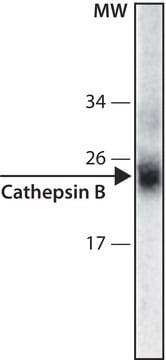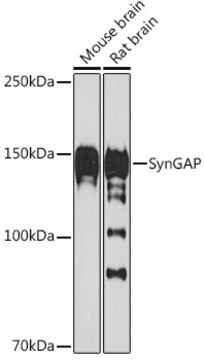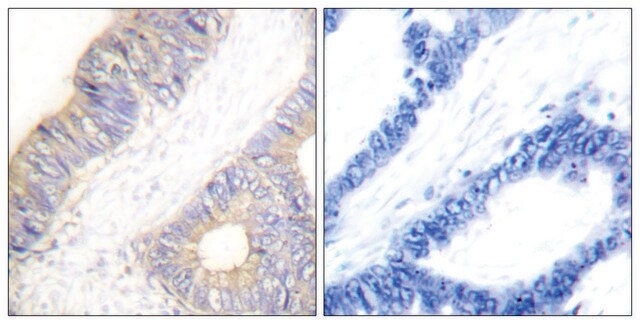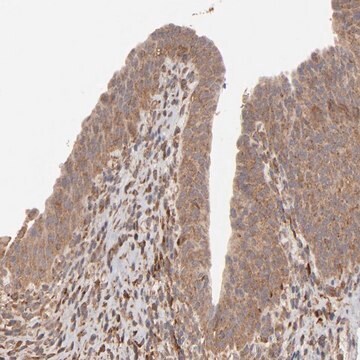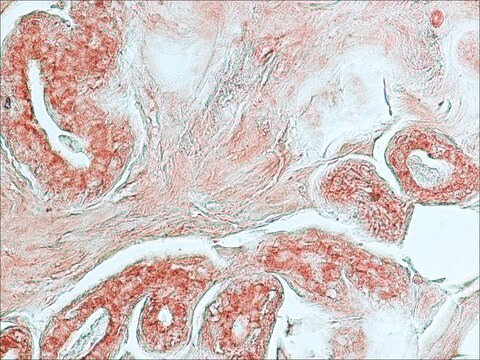一般說明
We are committed to bringing you greener alternative products, which adhere to one or more of The 12 Principles of Green Chemistry.This antibody is Preservative-free, produced without the harm or sacrifice of animals and exceptionally stable to allow for ambient shipping and storage if needed and thus aligns with "Waste Prevention", "Designing Safer Chemicals" and "Design for Energy Efficiency".
Click here for more information.
ZooMAb® antibodies represent an entirely new generation of recombinant monoclonal antibodies.Each ZooMAb® antibody is manufactured using our proprietary recombinant expression system, purified to homogeneity, and precisely dispensed to produce robust and highly reproducible lot-to-lot consistency. Only top-performing clones are released for use by researchers. Each antibody is validated for high specificity and affinity across multiple applications, including its most commonly used application. ZooMAb® antibodies are reliably available and ready to ship when you need them.
特異性
Clone 1G7 is a Rabbit recombinant monoclonal antibody that specifically detects Cathepsin B. It targets an epitope within 17 amino acids from the C-terminal half.
免疫原
KLH-conjugated linear peptide corresponding to 17 amino acids from the C-terminal half of human Cathepsin B.
應用
Quality Control Testing
Evaluated by Western Blotting in HT-1080 cell lysate.
Western Blotting Analysis: A 1:1,000 dilution of this antibody detected Cathepsin B in HT-1080 cell lysate.
Tested applications
Western Blotting Analysis: A 1:1,000 dilution from a representative lot detected Cathepsin B in HeLa cell lysate.
Affinity Binding Assay: A representative lot of this antibody bound Cathepsin B with a KD of 2.2 x 10-8 in an affinity binding assay.
Immunohistochemistry (Paraffin) Analysis: A 1:1,000 dilution from a representative lot detected Cathepsin B in human kidney tissue sections.
Note: Actual optimal working dilutions must be determined by end user as specimens, and experimental conditions may vary with the end user
標靶描述
Cathepsin B (UniProt: P07858; also known as EC:3.4.22.1, APP secretase, APPS, Cathepsin B1) is encoded by the CTSB (also known as CPSB) gene (Gene ID: 1508) in human. Cathepsin B is a dimeric thiol protease consisting of a light chain (aa 80-126) and a heavy chain (aa 129-333) and is synthesized as a proenzyme of 339 amino acids. It is synthesized with a signal peptide (aa 1-17) that directs it to the lumen of rough endoplasmic reticulum where the signal peptide is removed to generate the inactive procathepsin B with a propeptide sequence (aa 334-339). The propeptide functions as an inhibitor and stabilizes the enzyme. Procathepsin B is shuttled to the Golgi apparatus where it undergoes glycosylation at two asparagine residues. It is subsequently transported to lysosomes where under acidic conditions it undergoes autocatalytic activation following the activation peptide (aa 18-79) and propeptide (aa 334-339). Cathepsin B is a bilobal protein and its catalytic site is located at the interface between the two lobes. The amino acids cysteine, histidine and aspartic acid comprise the catalytic triad of the enzyme, with cysteine on the left lobe interacting with histidine on the right lobe to catalyze peptide bond cleavage. In contrast to other cysteine cathepsins of the papain-like family, it exhibits both endopeptidase and exopeptidase activity. It hydrolyzes proteins with broad specificity and preferentially cleaves Arg-Arg-|-Xaa bonds. Its expression is elevated in several human cancers at the mRNA, protein, and activity levels. It is also frequently overexpressed in premalignant lesions. During the transition to malignancy, cathepsin B localizes to the cell periphery and at the basal pole of polarized cells and active cathepsin B is secreted from tumors and facilitates in invasion and metastasis. This ZooMAb® recombinant monoclonal antibody, generated by our propriety technology, offers significantly enhanced specificity, affinity, reproducibility, and stability over conventional monoclonals. (Ref.: Cavallo-Medved, D., et al. (2011). AFCS Nat Mol Pages. 2011: A000508).
外觀
Purified recombinant rabbit monoclonal antibody IgG, lyophilized in PBS, 5% Trehalose, normal appearance a coarse or translucent resin. The PBS/trehalose components in the ZooMAb formulation can have the appearance of a semi-solid (bead like gel) after lyophilization. This is a normal phenomenon. Please follow the recommended reconstitution procedure in the data sheet to dissolve the semi-solid, bead-like, gel-appearing material. The resulting antibody solution is completely stable and functional as proven by full functional testing. Contains no biocide or preservatives, such as azide, or any animal by-products. Larger pack sizes provided as multiples of 25 μL.
儲存和穩定性
Recommend storage of lyophilized product at 2-8°C; Before reconstitution, micro-centrifuge vials briefly to spin down material to bottom of the vial; Reconstitute each vial by adding 25 μL of filtered lab grade water or PBS; Reconstituted antibodies can be stored at 2-8°C, or -20°C for long term storage. Avoid repeated freeze-thaws.
法律資訊
ZooMAb is a registered trademark of Merck KGaA, Darmstadt, Germany
免責聲明
Unless otherwise stated in our catalog or other company documentation accompanying the product(s), our products are intended for research use only and are not to be used for any other purpose, which includes but is not limited to, unauthorized commercial uses, in vitro diagnostic uses, ex vivo or in vivo therapeutic uses or any type of consumption or application to humans or animals.

